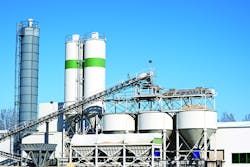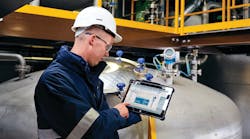Few products are as core to construction as concrete. Buildings, bridges, dams, highways and airport runways throughout the world are made of it. The Romans used it 2,000 years ago to build the Colosseum, which is still standing today.
Concrete’s key ingredient, cement, is made primarily to limestone with traces of other compounds to give it hardening and drying characteristics. Portland cement, the most common type, is made when crushed limestone and smaller amounts of other raw materials enter large rotary kilns that heat them to about 2,700ºF.
As the mix moves through the kiln’s fiery stages, some elements in it are driven off as gases. What remains forms a new substance called clinker that comes out of the kiln hot and is cooled to grey balls the size of marbles. Clinker, in turn, gets ground to a powder so fine that 1 pound contains 150 billion grains. It is then ready to ship, mostly to ready-mix concrete companies for construction projects.
In the U.S., Eastern Pennsylvania’s Lehigh Valley is both the birthplace and heart of the nation’s Portland cement industry because of the limestone deposits beneath it. The 42-square-mile area about 60 miles north of Philadelphia is home to five of the industry’s largest plants, including Keystone Cement.
Clinker monitoring challenge
Founded in 1928, Keystone completed a $230 million overhaul in 2010, making it one of the nation’s most technologically advanced and energy efficient production facilities. Its 150 employees and two cement kilns produce millions of tons of cement each year.
After cooling, Keystone’s clinker moves from the kilns to two large silos, one for the output of each kiln. The silos tower 195 feet, almost 20 stories, and are 78 feet wide. Each can hold 20,000 tons of clinker. As the newly produced clinker pours into the top of the silo, it is still between 280ºF and 300ºF and generates a lot of dust.
According to Paul DeLong, Keystone’s electrical maintenance manager, visibility into the silos’ clinker levels is critical to evaluating the plant’s overall production performance.
"If the clinker silos’ levels are not what we would predict by calculating how much raw materials goes into the preheater, what compounds are created in preheater, and the time and temperature in the kilns, then the plant isn’t producing enough clinker for the amount of material going in," he said. "That means money, energy and materials are being wasted."
DeLong also said that clinker silo levels can indicate what the plant’s finish mill rate should be with output from a 5,000 horsepower ball mill that powderizes the clinker. "The milling process is our last production step that crushes the clinker, creating our final product, Portland cement," he said.
Keeping accurate and timely measures of the clinker silo levels was difficult and could be dangerous because the company used a manual method. "We were sending men up to the top of the silos once a day to drop a weighted rope to measure their levels," DeLong said.
"This was done in two spots to average out the clinker’s angle of repose. It wasn’t convenient or efficient due to loss of man hours, and the measurements weren’t always precise," he said. "That’s not to mention the safety concerns anytime you send someone up almost 200 feet, sometimes in bad weather, and expose them to the hot, dusty conditions typical of inside the silos."
Solution
To solve the clinker silo measurement issues, Keystone preferred a way to continuously measure levels to better predict what the process is doing. The plant also wanted to be able to assess the quality of clinker coming from the kiln and cooling part of the production process.
The first instrumentation distributor Keystone contacted recommended ultrasound acoustic leveling technology, but after trying to install the large, bell-shaped units, they discovered that the existing process connection would not accommodate their size and shape.
DeLong contacted another local instrumentation source, Siemens distributor Ives Equipment Corporation, to help assess the situation and suggest an alternative solution. Account Manager Rory Kump visited Keystone and performed an evaluation that included a visit to the top of the silos and a look inside them.
In addition to the issue of physical size, Kump realized that the ultrasonic transmitters maximum operating range was just about the height of the silos. This meant that readings could be compromised as clinker levels get low in the 195-foot silos. He also concluded that their 300ºF upper end of the incoming clinker’s temperature range was identical to the maximum operating temperature for the units, which could stress the units and shorten their operating lifespans.
"This was a case of a solution application almost working," Kump said, "and in Keystone’s case, [it] almost wasn’t good enough. It shows how important [it is] to learn and consider all the various factors of an application’s operating environment before recommending a technology solution."
As an alternate solution, Kump suggested that Keystone install at the top of each silo a four-wire Siemens SITRANS LR460 radar level transmitter with a 24 gigahertz directional beam and dust cap.
Thinkstock/Courtesy of Siemens Industry Inc.
High signal-to-noise ratio
These level transmitters use frequency-modulated, continuous-wave radar with a high signal-to-noise ratio to continuously monitor solids in extremely dusty environments like Keystone’s clinker silos. The units’ monitoring range is 329 feet, and the medium temperature range is between -40ºF and 392ºF. Both parameters exceed the reach and range of the previous ultrasound acoustic leveling solutions.
The transmitter also includes advanced signal processing and onboard process intelligence. The units use echo detection algorithms based on the knowledge, experience and inputs from more than 1 million non-contacting leveling applications from around the world.
Dynamic time-vary threshold (TVT) technology auto-senses echo strength within Keystone’s silos. Echo reform in the model used at this plant also detects split echoes, which are typical of solids such as clinker that are in storage with varied slopes and multiple levels. This technology joins echoes together, eliminating drift to provide a more accurate and reliable signal.
Deployment
The radar level transmitter features a rugged enclosure, with flange and horn components. Keystone is using the optional dust cap to prevent excessive dust buildup inside the horn antenna due to the extreme dust inside the silos. The hot temperatures inside the silos do not affect the units because they are designed for harsh environments and work in even greater heat.
The physical installation of the units went smoothly, but once they were operating, the echo profile extracted from the unit showed that tuning was needed to ignore unwanted obstructions. Kump used a SIMATIC Process Device Manager to program out the anomalies in the devices via HART or PROFIBUS PA communications protocols, and since then, the plant reports that the level transmitters have been working well.
Results
Keystone now has continuous and precise measurements of its clinker volumes in both silos after installation of the radar level transmitters.
"Now our technicians in the control room can calculate the tonnage of clinker accurately and in real-time," DeLong said. "That’s been a huge help because they now always know how well our overall
cement-making process is operating and can make any needed adjustments to the raw materials going in or to the preheating process to keep it optimal.
DeLong does not have any hard metrics on how much cost savings have accrued due to the greater operational efficiencies, but he thinks they are substantial knowing the large kilns Keystone uses in its cement production make the process energy-intensive.
In fact, the kilns use about 17 million gallons of waste-derived fuel annually to replace half of the coal that they otherwise burn, so even a small percentage of improvement in process efficiency can translate to hundreds of thousands of dollars of annual cost-savings, not to mention the environmental benefit of fewer carbon emissions.
Technician productivity is another benefit. The manual measurement of each silo taking about an hour a day of a technician’s time is equivalent to 520 hours a year saved or about a quarter-year of a technician’s time. "We can calculate the cost savings of not having to send someone up there, but the real benefit is having them doing much more valuable work down on the ground," DeLong said. "Of course, keeping them on the ground also completely eliminates the risks of sending them up nearly 200 feet to take readings in a hot, dusty and caustic environment."
Herman Coello is the level marketing manager for Siemens Industry Inc. Based in Arlington, Texas, Coello is responsible for business development and marketing of radar, guided wave radar and ultrasonic level instruments. His experience with level instrumentation spans more than 25 years. He has been heavily involved with radar and ultrasonic level technologies training customers and sales representatives. He also markets Siemens radar transmitters and ultrasonics and transmitters and controllers that serve the oil and gas, food and beverage, water and wastewater, chemical, power, cement, aggregate and mining industries.



